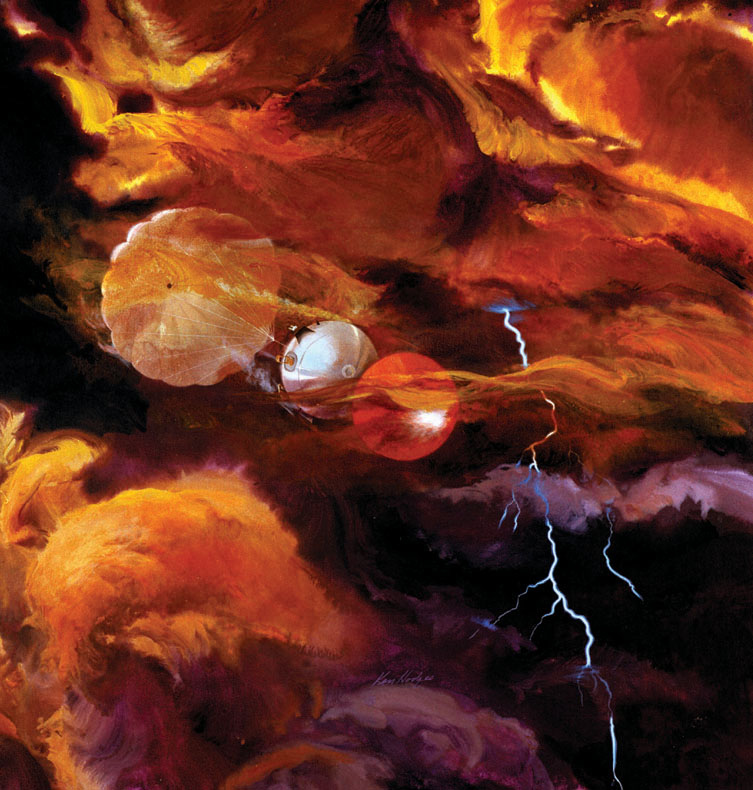12-5 The Galileo space probe explored Jupiter’s deep atmosphere

By observing Jupiter’s and Saturn’s cloud layers from a distance, we have been able to learn a great deal about the atmospheres beneath the clouds. But there is no substitute for making measurements on site, and for many years scientists planned to send a spacecraft to explore deep into Jupiter’s atmosphere. While still 81.52 million kilometers (50.66 million miles) from Jupiter, the Galileo spacecraft released the Galileo Probe, a cone-shaped body about the size of an office desk. While Galileo itself later fired its rockets to place itself into an orbit around Jupiter, the Galileo Probe continued on a course that led it on December 7, 1995, to a point in Jupiter’s clouds just north of the planet’s equator.
Exploring Jupiter’s Atmosphere
A heat shield protected the Galileo Probe as air friction slowed its descent speed from 171,000 km/h (106,000 mi/h) to 40 km/h (25 mi/h) in just 3 minutes. The spacecraft then deployed a parachute and floated down through the atmosphere (Figure 12-12). For the next hour, the probe observed its surroundings and radioed its findings back to the main Galileo spacecraft, which in turn radioed them to Earth. The mission ceased at a point some 200 km (120 mi) below Jupiter’s upper cloud layer, where the tremendous pressure (24 atmospheres) and high temperature (152°C = 305°F) finally overwhelmed the probe’s electronics.
Although the Galileo Probe did not have a camera, it did carry a variety of instruments that made several new discoveries. A radio-emissions detector found evidence for lightning discharges that, while less frequent than on Earth, are individually much stronger than lightning bolts in our atmosphere. Other measurements showed that Jupiter’s winds, which are brisk in the atmosphere above the clouds, are even stronger beneath the clouds. The Galileo Probe measured a nearly constant wind speed of 650 km/h (400 mi/h) throughout its descent. This shows convincingly that the energy source for the winds is Jupiter’s interior heat. If the winds were driven primarily by solar heating, as is the case on Earth, the wind speed would have decreased with increasing depth.
A central purpose of the Galileo Probe mission was to test the three-layer cloud model depicted in Figure 12-10a by making direct measurements of Jupiter’s clouds. But the probe saw only traces of the NH3 and NH4SH cloud layers and found no sign at all of the low-lying water clouds. (One explanation of this surprising result is that the probe by sheer chance entered an unusually warm and cloud-free part of Jupiter’s atmosphere.)
The Galileo Probe also made measurements of the chemical composition of Jupiter’s atmosphere. These data revealed that the relative proportions of hydrogen and helium are almost exactly the same as in the Sun, a finding in line with the accepted picture of how Jupiter formed from the solar nebula (see Section 8-4). But a number of heavy elements, including carbon, nitrogen, and sulfur, were found to be significantly more abundant on Jupiter than in the Sun, which was an expected result. Over the past several billion years, Jupiter’s strong gravity should have pulled in many pieces of interplanetary debris, thus building up a small but appreciable abundance of heavy elements.
Noble Gases and the Origin of Jupiter
Another surprising and potentially important result from the Galileo Probe concerns three elements, argon (Ar), krypton (Kr), and xenon (Xe). These elements are three of the six so-called noble gases, which do not combine with other atoms to form molecules. (The noble gases, which also include helium, appear in the rightmost column of the periodic table in Box 5-5.) All three of these elements appear in tiny (or trace) amounts in Earth’s atmosphere and in the Sun, and so must also have been present in the solar nebula. But the Galileo Probe found that argon, krypton, and xenon are about 3 times as abundant in Jupiter’s atmosphere as in the Sun’s atmosphere.
Measuring trace amounts of rare gases on Jupiter provides clues about the origins of the planets.
If these elements were incorporated into Jupiter directly from the gases of the solar nebula, they should be equally as abundant in Jupiter as in the Sun (which formed from the gas at the center of the solar nebula; see Section 8-3). So, the excess amounts of argon, krypton, and xenon must have entered Jupiter in the form of solid planetesimals, just as did carbon, nitrogen, and sulfur. But at Jupiter’s distance from the Sun, the presumed temperature of the solar nebula was too high to permit argon, krypton, or xenon to solidify. Left in their warmer gaseous form, it is unclear how Jupiter could have accumulated so much of these gases. How, then, did the excess amounts of these noble gases become part of Jupiter?
One hypothesis proposes that Jupiter originally formed much farther from the Sun. Out in the cold, remote reaches of the solar nebula, argon, krypton, and xenon could have solidified into icy particles and fallen into the young Jupiter, thus enriching it in those elements. Interactions between Jupiter and the material of the solar nebula could then have forced the planet to spiral inward, eventually reaching its present distance from the Sun. Although we saw in Section 8-7 that some migration of planets is expected, current models do not support Jupiter forming so far away. When the Juno spacecraft arrives at Jupiter in 2016, it can help to solve the mystery of Jupiter’s noble gases.
CONCEPT CHECK 12-5
Why is it difficult to understand that Jupiter has greater abundances of noble gases than the Sun?
We expect the Sun and Jupiter to have formed from the same material—the solar nebula—each with the same abundances of noble gases. Because the noble gases do not undergo chemical reactions with other atoms and molecules, their observed abundance today is thought to be representative of the abundance when the Sun and Jupiter formed.